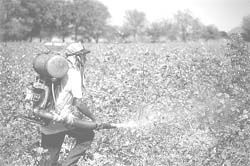Operation pest guard
 in india, cotton is grown in about 2.60 lakh hectares of land. This is equivalent to approximately 35 per cent of the gross cultivated area. Yet, nearly 50 per cent of the total pesticidal consumption is in cotton farming alone. Thus, the extent of damage that pests and diseases can inflict on cotton crops can assume grave proportions. Excessive use of pesticides invites hazards such as pest resurgence and resistance and residue of pesticides in cotton seeds and lint. However, these problems can be effectively countered by extensive adoption of integrated pest management ( ipm ) methods. It has gone a long way in pest management practices in many South Asian countries like Indonesia and Thailand. In India, the declining trend in the use of pesticides conveys the message that alternate methods of pest control are gaining momentum. ipm is nothing but a meticulous combination of all the available methods of pest control strategies over a period of time.
in india, cotton is grown in about 2.60 lakh hectares of land. This is equivalent to approximately 35 per cent of the gross cultivated area. Yet, nearly 50 per cent of the total pesticidal consumption is in cotton farming alone. Thus, the extent of damage that pests and diseases can inflict on cotton crops can assume grave proportions. Excessive use of pesticides invites hazards such as pest resurgence and resistance and residue of pesticides in cotton seeds and lint. However, these problems can be effectively countered by extensive adoption of integrated pest management ( ipm ) methods. It has gone a long way in pest management practices in many South Asian countries like Indonesia and Thailand. In India, the declining trend in the use of pesticides conveys the message that alternate methods of pest control are gaining momentum. ipm is nothing but a meticulous combination of all the available methods of pest control strategies over a period of time.
Summer ploughing is necessary in the fields where cotton is to be grown as it destroys dormant insects in the soil. Cotton should also be rotated with other cereal and pulses, and when the last ploughing is done, 100 kg of neem cake should be added to every 0.4 ha of land. While planting cotton, it should be intercropped with greengram and cowpea or clusterbean. This minimises the incidence of leafhoppers and aphids during the later stages. Castors and chrysanthemum should also be sown as border crops.
When the cotton seedlings are 25 to 30 days old, drenching with neem oil combined with water wards off stem weevils. Alternatively, carbon granules can also be applied. Any curative measure taken at a later stage cannot contain stem weevil as effectively as these measures. The next stage in the growth of cotton is the vegetative stage and the crop faces the danger of being attacked by what are called sucking pests. To ward off these pests, selective control measures have to be taken when cultivating the border crops. Yellow sticky traps are also effective in controlling white flies. To do this, empty tin containers or used pesticide cans should be painted golden yellow and smeared with castor oil. These yellow cans should be tied to bamboo stakes and placed randomly in the cotton fields. They attract white flies, which then get trapped inside.
Finally, the vegetative stage is followed by the flowering and boll formation stage. Green and pink bollworms tend to attack the crop at this stage. To control these pests, setting up of pheromone (a chemical secreted by an organism which attracts other organisms) traps is the most effective method. If the bollworm incidence increases, trichogramma egg parasites can also be released into the field every fortnight. Despite these measures, if the incidence of bollworm is not controlled, then spraying can be done with neem pesticides followed by one or two rounds of chemical pesticides at a recommended dosage. Thus an ipm schedule can be prepared for different growth stages and different ipm components should be systematically amalgamated to effectively manage pest and disease incidence in cotton.
